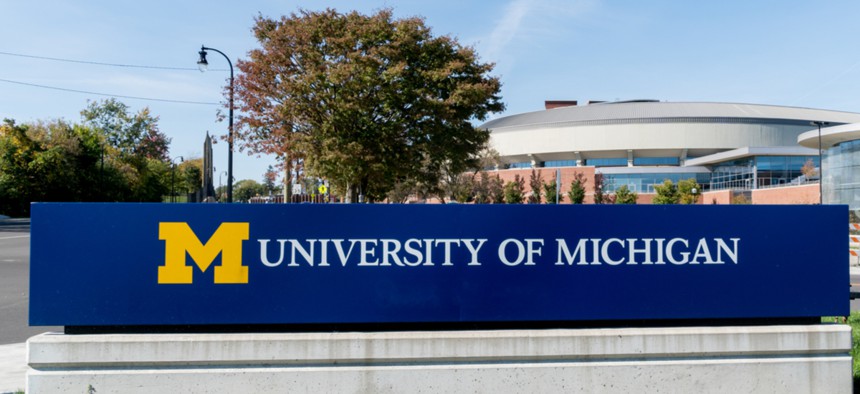A Guarantee of Tuition-Free College Can Have Life-Changing Effects

Entrance sign to the campus of the University of Michigan at Ann Arbor. Shutterstock

Connecting state and local government leaders
A mailer sent to low-income students with that promise led to a major jump in enrollment at the University of Michigan, according to a new study.
Highly selective colleges have long struggled with racial and economic diversity. At 38 such institutions in the United States, more students come from households in the top 1 percent than from those in the bottom 60 percent. That is in part due to who applies to the universities: Many high-achieving students from a low-income or minority background don’t think they can get in to a prestigious institution, let alone pay for it—despite the fact that many such colleges have generous financial-aid packages—so they end up not applying.
A new study, however, found that a few extra dollars on a university’s part might go a long way in terms of changing that calculus for low-income students. The working paper, published by the National Bureau of Economic Research, examined the effects of a targeted-outreach campaign for low-income students at the University of Michigan.
The campaign, known as the High Achieving Involved Leader (HAIL) Scholarship, encourages highly qualified, low-income students to apply to the university, promising them four years of education free of tuition and fees. Students are sent a personalized mailing with all of the information, which costs the university less than $10 each to produce and send out; the students’ parents and school principals are also contacted separately. And the offer of free tuition isn’t contingent upon filling out financial-aid forms such as the Free Application for Federal Student Aid (FAFSA).
The researchers, led by the University of Michigan economist Susan Dynarski, found “very large effects of the HAIL scholarship offer on application and enrollment rates at the University of Michigan and more generally on college choice.” Students who received the mailing were more than twice as likely to apply to the University of Michigan compared with a control group. The percentage of low-income students enrolling at the university more than doubled as well—from 13 percent in the control group to 28 percent in the group of students who received the mailer.
The HAIL Scholarship is a new program, but even without it the students would likely have been able to attend the University of Michigan free of charge—90 percent of similarly situated high-achieving, low-income students receive full-tuition scholarships. But HAIL makes that fact explicit: It isn’t that students can apply and have the chance to afford the college—if they apply and are accepted, it is guaranteed.
The study shows one way to tackle the phenomenon known as “undermatching,” which is when high-achieving students don’t attend the most selective college they could get into. It’s something researchers have studied and worried about for several years now, since it tends to occur most frequently among low-income students. While it has been argued that there’s too much attention being focused on getting low-income students into a small number of elite colleges, as I’ve previously written, students who undermatch are less likely to graduate than their peers who don’t, and they forgo a range of social benefits accrued from attending an elite college.
In some cases, the students enrolling at Michigan wouldn’t have gone to college at all had they not had been contacted. “One-quarter of the enrollment effect (four percentage points) is driven by students who would not have attended any college in the absence of the treatment,” the authors of the report wrote. “The balance would have attended a community college or a less selective four-year college in the absence of the treatment.”
For the researchers, the next step in evaluating the program is to track its effects on students’ choice of major, graduation rates, and, in the long term, lifetime earnings. But for now, the results “show that a low-cost, low-touch intervention can strongly affect student application and enrollment at selective colleges.”
This is the second study in the past week showing the positive effects of a guarantee for low-income and minority students. A study published by the American Educational Research Association found that undermatching is reduced when low-income students know that their admission is ensured through state policy. The study examined the University of Texas system and its “top 10 percent plan,” which guarantees admission to students in the top 10 percent of their high-school class.
In both the Michigan and Texas studies, the students were given clear information that going to college—and to an elite college, at that—was a real possibility. As Kalena Cortes, an associate professor at Texas A&M and one of the Texas study’s authors, said, “Demystifying college-admissions policy is a pathway to greater inclusion.”
Adam Harris is a staff writer at The Atlantic, which originally published this article.

NEXT STORY: Meet the Craft Distillers of Native America




